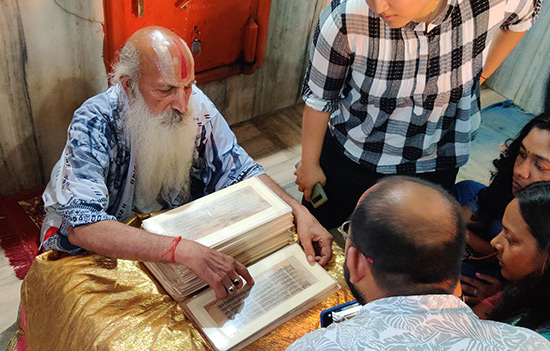- A sacred
journey to meet Pandit Ramashraya Tripathi Ji, a present-day disciple in the lineage
of Goswami Tulsi Das. Also see Ganesh Temple, Karwi made by Maratha ruler.
While I was
on a field
trip to Chitrakoot , along with my team working on a project on Integral
Humanism, we visited the birth place of Goswami Tulsi Das. It was a blessed
moment for us and an incredible opportunity to meet Pandit Ramashraya
Tripathi Ji, a present-day shishya
(disciple) in the esteemed lineage of Goswami Tulsi Das.
Our meeting
unfolded in the birthplace of Tulsi Das, a sacred site located on the serene
banks of the Yamuna River in Rajapur, Karwi, Uttar Pradesh. Meeting with Pandit
Ramashraya Tripathi Ji and the exploration of the treasured handwritten
manuscript of Ramacharita Manasa under his custodianship became a profound and
enlightening experience.
A
Gʟɪᴍᴘsᴇ into the Sᴘɪʀɪᴛᴜᴀʟ Mᴀsᴛᴇʀᴘɪᴇᴄᴇ
As we engaged in conversation with Pandit Ramashraya Tripathi Ji, the spiritual masterpiece Ramacharita Manasa took on a new life before our eyes. His profound knowledge and unwavering devotion brought the verses penned by Goswami Tulsi Das to life, allowing us to delve into the depths of devotion and eternal wisdom. Each stroke of Tulsi Das' pen on those ancient pages whispered tales of divine love, devotion, and spiritual insight, resonating deeply within our hearts.
 Author with Pandit R Tripathi Ji. Pranams.
Author with Pandit R Tripathi Ji. Pranams.
Tʜᴇ
Tʀᴇᴀsᴜʀᴇᴅ Hᴀɴᴅᴡʀɪᴛᴛᴇɴ Mᴀɴᴜsᴄʀɪᴘᴛ
Under Pandit Ramashraya Tripathi Ji's custodianship, we were granted the rare privilege of witnessing the treasured handwritten manuscript of Ramacharita Manasa. The manuscript, preserved with utmost care, held within its pages the essence of Tulsi Das' divine inspiration. It was a moment of reverence and gratitude as we connected with the spiritual legacy handed down through generations.
 Pandit R Tripathi Ji explaining the Ramacharita Manasa manuscript to us.
Pandit R Tripathi Ji explaining the Ramacharita Manasa manuscript to us.
Nᴏᴛᴀʙʟᴇ
Fᴀᴄᴛs ᴀʙᴏᴜᴛ Mᴀɴᴜsᴄʀɪᴘᴛ ᴏғ Rᴀᴍᴀᴄʜᴀʀɪᴛᴀ Mᴀɴᴀsᴀ
A. The manuscript of Ramacharita Manasa was discovered
in the waters of the Yamuna River. Unfortunately, the majority of the
manuscript, including all the kandas
(chapters), had been damaged or lost. Only the portion containing the Ayodhya
Kanda remains. It consists of approximately 170 pages, with seven stanzas
meticulously scripted on each page.
B. The available pages of the manuscript have been
preserved using a specialized laminating technique, influenced by Japanese
preservation methods. This meticulous preservation ensures the longevity and
protection of the precious manuscript for generations to come.
C. Tulsi Das chose to write Ramacharita Manasa on
paper, which was already in use nearly four hundred years prior to his time.
The manuscript was written in Avadhi, a language of the medieval period. Tulsi
Das used a natural ink made from ingredients
such as aamla (Indian gooseberry), guggula (a resinous tree sap), black
collyrium powder, and various herbs. Remarkably, Tulsi Das embarked on this
poetic endeavor at the age of 76, completing the entire text in two and a half
years.
D. Pandit Ramashraya Tripathi Ji belongs to the
eleventh generation of disciples originating from Sri Ganpat Ram Upadhya, who
was the first disciple of Tulsidas himself. This lineage of disciples has
diligently preserved the teachings and manuscripts of Tulsi Das, ensuring their
continuation through the generations. It is through this lineage that the
invaluable manuscript of Ramacharita Manasa has been safeguarded and passed
down.
E. Reading and deciphering the manuscript requires a thorough understanding of the script used during Tulsi Das' time. Approximately fifteen characters employed in the manuscript are no longer in use in the modern Devanagari script. Acquiring knowledge of these specific characters is essential for accurate interpretation and comprehension of the text.
The manuscript of Ramacharita Manasa, indeed, is a remarkable treasure that has endured the test of time. Its recovery from the Yamuna River, preservation techniques, Tulsi Das' use of paper and natural ink, and the dedicated lineage of disciples led by Pandit Ramashraya Tripathi Ji showcase the unwavering commitment to preserving the invaluable works of Tulsi Das.
Let us appreciate the dedication and
efforts of those involved in safeguarding this priceless manuscript, ensuring
that the spiritual legacy of Tulsi Das continues to inspire and enlighten
generations to come.
 Birth-room of Sant Tulsidas.
Birth-room of Sant Tulsidas.
Tʜᴇ
Bɪʀᴛʜᴘʟᴀᴄᴇ ᴏғ Gᴏsᴡᴀᴍɪ Tᴜʟsɪ Dᴀs
Immersed in the ambience of Rajapur, Karwi (40 kms from Chitrakoot), where Tulsi Das took his first breath, we found ourselves transported to a sacred realm. Sitting on the banks of the Yamuna River, we listened to the enchanting stories of Tulsi Das' life, his devotion, and the spiritual journey that led him to pen the verses of Ramacharita Manasa. The aura of this place stirred a deep sense of enlightenment, connecting us with the profound wisdom of Tulsi Das.
Aɴ
Eɴʟɪɢʜᴛᴇɴɪɴɢ Exᴘᴇʀɪᴇɴᴄᴇ
Our meeting with Pandit Ramashraya Tripathi Ji, the custodian of Tulsidas' legacy, and the exploration of the birthplace of Goswami Tulsidas provided us with an enlightening experience. It was a precious moment in which we felt the profound impact of devotion, wisdom, and divine inspiration. The meeting left an indelible mark on our hearts, reminding us of the eternal teachings encapsulated within the verses of Ramacharita Manasa.
As we departed from this sacred place, we carried with us a renewed understanding of the spiritual journey and the significance of devotion in our lives. The connection we forged with Tulsi Das' legacy and the opportunity to witness the treasured manuscript served as a catalyst for personal growth, inspiring us to embrace the teachings of love, devotion, and spiritual wisdom in our own journeys.
May his
teachings continue to guide us on the path of love, devotion, and spiritual
enlightenment.
All pictures by author.
To read all articles by author
Read About Ganesh Temple, Karwi built by a Maratha ruler